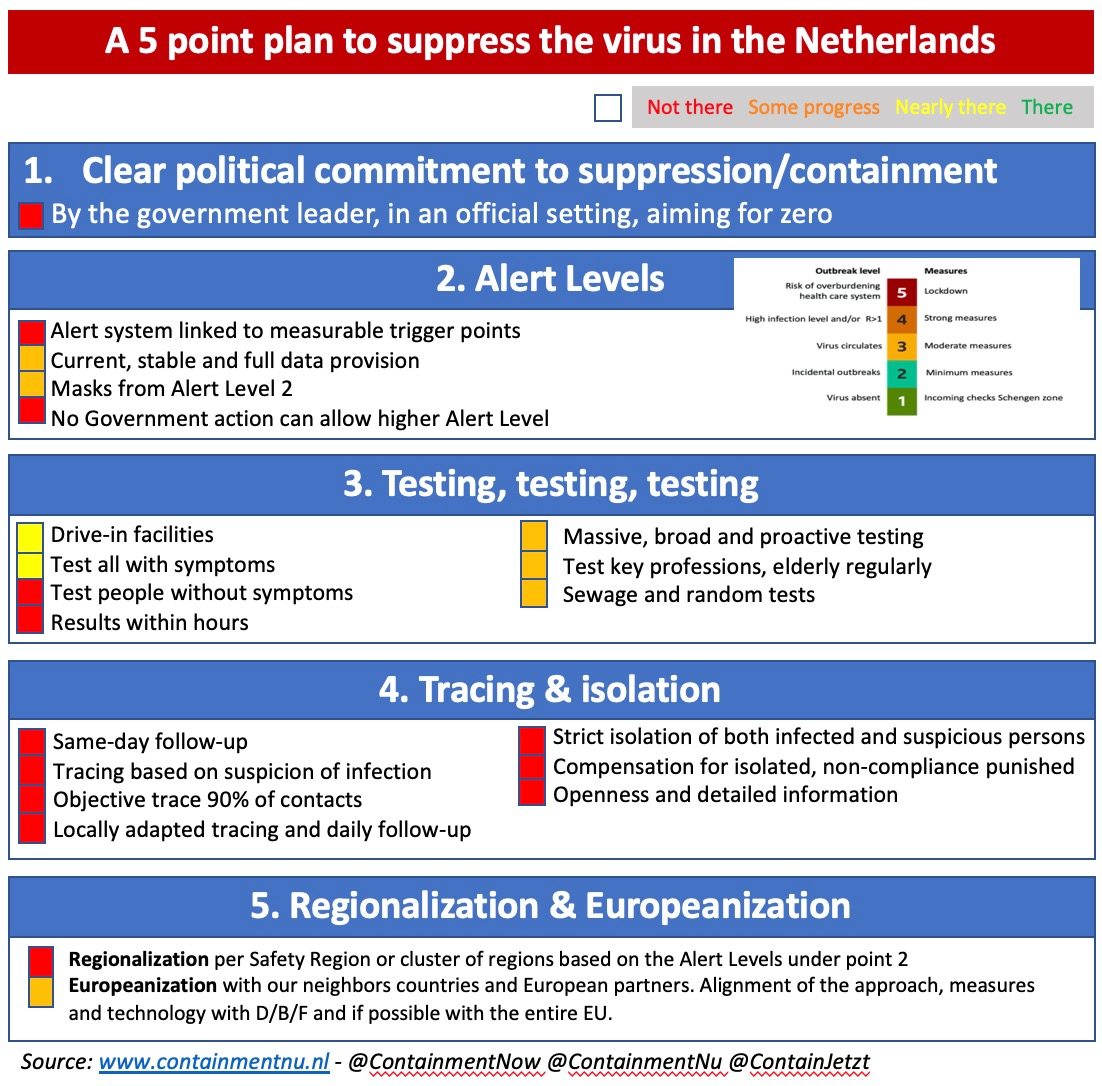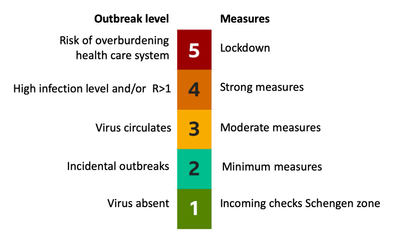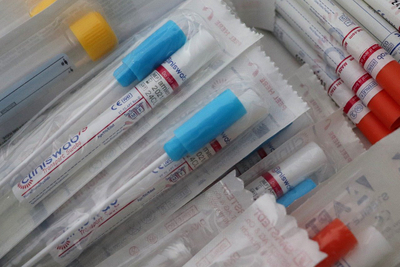This plan is made by Containment Nu, a grassroots, citizen led organization that campaigns for a transition from a mitigation strategy to containment or eradication of COVID-19 in The Netherlands and elsewhere. It is based on months of research into succesful containment approaches in other countries and interviews with field epidemiologists, doctors and insiders in the healthcare sector and health care consultancy.
- Clear political commitment "towards zero"
- Warning level system
- Mass testing, also proactive
- World-class source and contact research
- Regionalization and Europeanization
Here is the "Dashboard" for the Netherlands on June 21th. At the most recent update on August 2nd, little had changed.
Update: visit monitor.containmentnow.org for a comparison between countries.

This article serves as a guide for a comprehensive plan to suppress the Corona virus. It was developed for the Netherlands but much of it should be useful in other parts of the world. The Dutch have been relaxed about allowing the virus to spread, and time is running out with the Fall flu season coming up in a few months and worrying signs of rising infections despite the Summer "outdoor living" season.
In the first place, this requires a strategy change to an R (reproduction number) well below 1 and the goal of first getting the virus to zero (with occasional outbreaks) and then moving towards European elimination and then worldwide eradication of the virus. If the government acts along these lines in the coming months, we are on the way to serious containment and a return to health, prosperity and freedom.
Our simple 5 point plan for suppression
After consultation and extensive research, we present our 5-point plan. This plan is compatible with the advice of the WHO and the containment advice of KMPG and the Free University of Amsterdam, but elaborated in more detail for the Netherlands. The recommendations also seek to tie the hands of our government, which has often not merited the huge trust put in it by the public. The details in this plan are not definitive, please contact us with suggestions!
1. Clear political commitment to contain and suppress the virus
Real and full suppression starts with political will, which must therefore be clearly stated. Governments in the transparency business have done so. Prime Minister Mark Rutte should stop talking about "ICU-based mitigation" (keeping up the tempo) while also aiming for "as little virus as possible", but make a speech containing the lines:
- "This is a dangerous and unknown virus that we do not tolerate in our society"
- "We are going to zero in a few months"
- "After that we only tolerate occasional outbreaks, which we then hit hard"
- "We must eventually eliminate and then eradicate the virus in Europe and the world."
Some measure of self-examination and apologies for the policy of "maximum control" with controlled dissemination for the purpose of immunity-building toward Herd Immunity would make the commitment more credible. A parliamentary inquiry into how things got so bad in our nursing homes, supermarkets (massive hoarding) and social fabric (distance rules, long lockdown) is inevitable, but not urgent for now. Nor is external independent research urgent, because we simply know what to do, based on the many success stories in countries from New Zealand to Slovenia and Luxembourg. Read on!
2. Warning level system with stepped control measures
Like several other countries, we need to set "Alert Levels" to increase policy transparency. This makes the measures much easier to understand for the general population and creates hopes for the future, thus increasing public support for measures. It also makes measures more predictable for business, which will limit economic damage. And it forces the government to never take measures or allow behavior that will result in a higher Alert Level.

This alert system also requires much better, faster, more consistent and stable government information about infections, testing, mortality and recovery. In the Netherlands, this information is currently slow to arrive, limited, and variable in its reporting format, making life a nightmare for data analysts. That is presumably intentional, since Mitigation and immunity buildup cannot stand the light of day and public scrutiny..
More detail on the type of measures that would belong to the Levels (each higher level naturally includes the measures of the level below).
- (0 infections for 1 month) Travelers into our "Green Zone" (in principle the Schengen zone or the entire EU) are tested, and quarantined after a positive test. Travelers from risk areas are always quarantined.
- (0 infections in the past 2 weeks) Government campaigns to nudge behavior (washing hands, coughing in the elbow, keeping distance, holding meetings outside, opening windows for ventilation/enhanced airing systems, protection for the vulnerable). Very large (1000+) indoor events prohibited. Mask requirement in public transport and shops, and during events. Droplet screens in shops, public transport, building receptions.
- (0-50 infections / 100,000 inhabitants / week) Events prohibited. Indoor locations require 1.5m distance and a maximum number of visitors. Face mask requirement in public places. Schools at half capacity and with masks. Care/nursing homes closed to visitors.
- (>50 infections / 100,000 / week and/or TTI overwhelmed) Indoor locations where people are not just passing through (e.g., offices, cultural sector, medical care) are closed. Traveling by public transport (including flying) only for essential travel. Schools closed.
- (ICUs nearing capacity) Everyone in non-essential professions stays at home except for groceries, medical care and exercise. Hospitals closed to non-urgent cases.
The mask requirement allows all nose and mouth coverings, including homemade ones, because they can effectively curb the epidemic. Surgical masks are recommended. People at increased risk can always wear an FFP2+ respirator and glasses and are informed about the risks and benefits. Given the likelihood that ventilation, or lack thereof, can be a factor in viral spread indoors, significant attention will need to be given to ventilation systems in offices, schools and other public spaces. As the Science improves, so will these ECDC guidelines and the authorities will need to work with building owners to create workable and effective regulations.
3. Mass testing, also proactive
Currently, only people with complaints are tested, by appointment, in often hard-to-reach locations. The process can take a week. We must have a world-class testing system. The importance of test trace isolate (TTI) must also be communicated to the population, since not all seem to understand the importance of this suppression measure. This requires an extensive information campaign.

- Drive-in / walk-in test facilities. You come in, you're tested. If you can't come, they'll come over. Also test people without complaints/symptoms..
- Results within hours; therefore testing should be done in hospitals where the laboratories are, wherever possible
- Massive, broad and proactive testing, including regular testing for professions such as teachers, reception clerks and bus drivers, even without a suspicion of infection
- Healthcare personnel and their patients deserve excellent protection materials, but also an even more active testing regime, at least twice weekly. Frequent testing of nurses and doctors turned out to be key in the containment of the outbreak in Groningen.
- Sewage testing, frequent sampling tests in schools and offices and other proactive testing methods are also essential for proper monitoring.
Obviously, proactive testing of professional groups can be phased out as the Alert Level drops to 2 and 1 and replaced by random or structural sample testing at sewage treatment plants and elsewhere.
4. World-class source and contact tracing and isolation/quarantine
What does good source and contact tracing look like? Based on recommendations from the European Center for Disease Control and a survey of 8 European public health experts, we arrive at the following elements:
- Quick start with tracing after a positive test, wherever possible the same day
- Tracing also starts based on suspicion of infection, not just based on a positive test
- Objective is to trace 90% of contacts
- Thorough and locally adapted source and contact tracing and follow-up during quarantine, with a feeling for cultural differences and local customs
- Strict isolation of both infected and suspicious persons. Daily follow-up helps those in isolation to stay at home, as well as financial compensation and criminal liability for those who go out during home isolation
- National tracking of infections, leading up to a complete trace of all infections
- Regionalization of the approach, both in terms of intensity and interpretation of isolation measures (see below)
- Openness and detailed information for researchers and citizens about the course of tests and tracing. There is no such thing as too little data.
- The Inspectorate for Health Care IGJ needs to take up its role as regulator of the quality of TTI.
Such an approach requires a significant upscaling of tracing capability. Field epidemiologists such as Dr. Amrish Baidjoer and Arnold Bosman MD can help the government in this. It is not a given that the GGDs (Community/Regional Public Health Units) are the best organizations to implement this in every Veiligheidsregio (police/safety/public health region), so a division of tasks can also be useful.
5. Regionalization and Europeanization
Regionalization is the way forward. Our province of Groningen has always remained almost free of Corona virus (despite not being an island), which is proof of the effectiveness of serious testing and tracing that Prof. Alexander Friedrich organized there in March. It is not clear now why the same strict measures should apply there as in areas where serious infection levels are still present (the South of the Netherlands, the Randstad conurbation). That is bad for the economy, for public support and for fighting the outbreak. Therefore, regionalization of the measures is necessary. This could be done per safety / GGD region or per cluster of such regions (North, Randstad-North, South, etc.)
Of course, regionalization is the natural ally of the Alert Levels under point 2. This makes it easier for citizens who move from (e.g.,) a Zone 3 to a Zone 2 to know what is expected of them there.
Europeanization is also necessary. We are a small country very dependent on our open borders. Continuing to allow the virus to spread (the standing policy from March to the present day) is impossible on your own (closed outgoing borders!), but so is full suppression (inbound travel!). It is therefore necessary to coordinate our approach with our neighboring countries and European partners. At the minimum, our approach in the Netherlands cannot differ materially from that in Germany, Belgium and France. And the most logical approach is of course for Europe to have a common approach:
- The same warning levels with the same measures per level
- The same corona warning app (we should probably adopt the German app, already launched)
- The same entry rules at the external borders (testing, quarantine)
- Exchange of information and compatible Dashboards and information.
A ray of hope
The past months have ripped many wounds in society. But we have the opportunity and tools to move toward a return to near-normality whilst saving so many lives. The Dutch authorities have served as an example of how not to respond to the biggest crisis most of us have ever lived through (or died in). But the plan presented in this piece shows the way forward. And in so doing also contrasts how fare we stil have to go to move toward serious suppression of the virus, and provides a framework for evaluating progress.
Those of good will, unite! Organize, join us, mail or tweet your MP, write articles, protest. The current daily deaths and social distancing are bad enough, but we may lose much of what we love if we allow a second big wave to hit us in the second half of the year.
Reference list and resources
- New Zealand's Alert System
- COVID-19 Alert-Level System Indicators, Triggers and Thresholds
- endcoronavirus.org
- The Hammer and the Dance
- rivm.nl/en
- ECDC report on Contact Tracing
- Euronews: UN chief Antonio Guterres slams countries for ignoring WHO advice